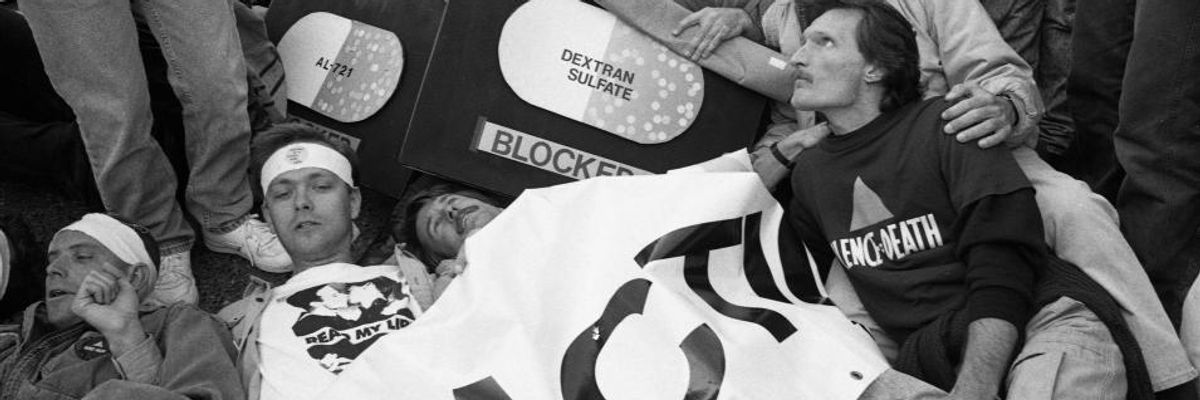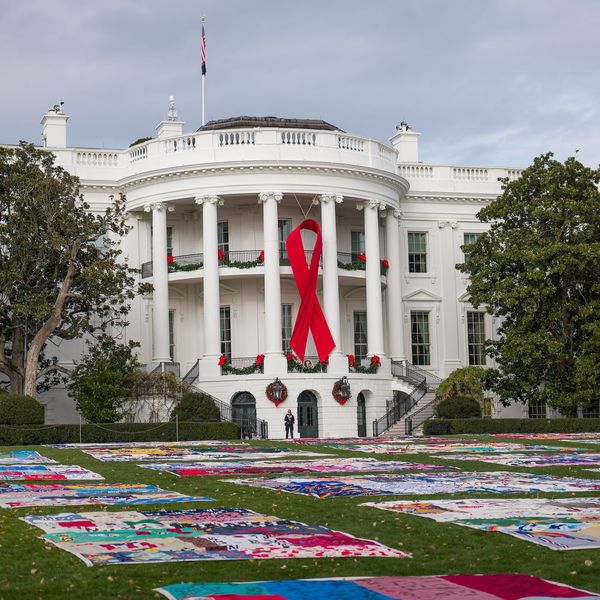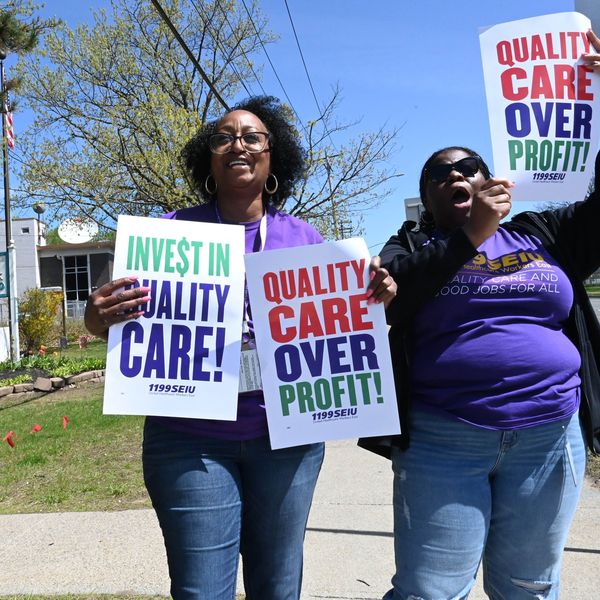
AIDS activist group ACT UP (AIDS Coalition to Unleash Power) protest at the headquarters of the Food and Drug Administration (FDA) on October 11, 1988 in Rockville, Maryland. The action, called SEIZE CONTROL OF THE FDA by the group, shut down the FDA for the day. (Photo by Catherine McGann/Getty Images)
Love One Another or Die: Lessons for Coronavirus From the HIV/AIDS Crisis
We learned to fight militantly and angrily for healthcare, in a country where healthcare is not a universal right. It made all the difference.
There's something surreal about the present admonitions coming from public health advisors and officials: Don't touch your face. Stay home and avoid social contact with others. Expect measures like shutdowns, lockdowns, quarantines, and social distancing to remain in place for up to 18 months.
And even after that, who knows? The virus might mutate, outwitting herd immunity, vaccinations, and antiviral treatments. Trump has conjured images of celebration once the crisis has passed, while others have suggested that nothing will go back to the way it was. Neither suggestion is helpful.
Experience with HIV/AIDS suggests that behavioral modifications can curb the worst of pandemics. But they are imperfect and only work up to a point.
Vivid lessons were in front of us in the 1980s and 1990s. Death from complications related to HIV were every bit as horrifying then as death by asphyxiation and organ failure are in the present pandemic.
And so, faced with an avalanche of gruesome, untimely deaths--and by the somber realization that up to half the urban gay male community was already HIV-positive by the time the disease became evident--gay communities everywhere mobilized resources and labor to provide care, to educate, and to encourage behavioral changes.
We embraced the Condom Code. We also decided, for the most part, to go on living, loving, sharing friendships, and having sex--albeit with precautions.
After decades of outreach and education, the results have been mixed.
Gay men wear condoms, but neither consistently nor--it turns out--indefinitely. Recent pre-exposure prophylaxis treatments show promise in patching these gaps and reducing HIV transmission. But even so, gay and bisexual men still account for about 80% of the total HIV caseload and 70% of all new infections.
Deaths from HIV are way down, thanks to effective antiretroviral therapies. But overall the number of people living with HIV has increased, albeit at a slower rate than in the past. There are still about 39,000 new infections per year. And even in an era of rapid, accurate testing, an estimated 1 in 7 seropositive persons don't know that they are positive.
Reasonable people concluded long ago that "not one case more" was an unreasonable goal, and they were right about that. We strove instead to lower infection rates to the point where the pandemic would cease to expand and would, essentially, collapse on itself. We've gained a lot of ground but we're still striving for that reverse inflection point.
If we learned anything from our experiences with HIV/AIDS, it is something like this: Strategies like abstinence, which take the pleasure out of life (and were prominent among the first responses to the crisis) are counterproductive. We learned to fight militantly and angrily for healthcare, in a country where healthcare is not a universal right (and where many believed that AIDS was God's punishment for homosexuals). We also learned something about risk. You can lower your risks, you can manage your risks, but you can't live a risk-free life.
Experiences a century ago with the much-faster-moving and far more communicable "Spanish Flu" perhaps provide more applicable lessons. Quarantines and lockdowns did indeed slow the pandemic. But such measures couldn't be imposed indefinitely. The second wave of deaths, spread by a mutated form of the virus, was far more severe than the first.
There is a sad and terrible lesson here. People in societies around the world took their losses, mourned the dead, and eventually moved on. There is also an upbeat lesson. Life went back to normal after a terrible ordeal.
There is still much that we do not know about COVID-19.
We still don't know what the mortality rate for the illness is--or will be--because testing, treatment, and healthcare conditions vary dramatically from country to country.
What we do know is that the rate of patients with serious symptoms will be high enough--in the days, weeks, or even months ahead--to overwhelm even the best healthcare systems, flooding hospitals with people in need of intensive care and ventilators.
We also know that mortality rates will skyrocket if hospitals are overwhelmed.
Thus, public health strategies everywhere are employing some combination of containment (quarantining and isolating those who have been exposed) and mitigation (measures like social distancing and school closures) in order to slow the spread of the virus.
For the time being, the right and proper goal is to slow the virus down--to "flatten the curve"--so as to avoid collapse of the healthcare system and to ensure that those most affected by the virus receive life-saving care.
And here's what we ultimately learned from our long battle against HIV/AIDS: we learned that love for our friends, families, and community--and our fierce battle for their healthcare rights and humanity--was what saved us. It did not save us all, but it saved more than we can ever count.
An Urgent Message From Our Co-Founder
Dear Common Dreams reader, The U.S. is on a fast track to authoritarianism like nothing I've ever seen. Meanwhile, corporate news outlets are utterly capitulating to Trump, twisting their coverage to avoid drawing his ire while lining up to stuff cash in his pockets. That's why I believe that Common Dreams is doing the best and most consequential reporting that we've ever done. Our small but mighty team is a progressive reporting powerhouse, covering the news every day that the corporate media never will. Our mission has always been simple: To inform. To inspire. And to ignite change for the common good. Now here's the key piece that I want all our readers to understand: None of this would be possible without your financial support. That's not just some fundraising cliche. It's the absolute and literal truth. We don't accept corporate advertising and never will. We don't have a paywall because we don't think people should be blocked from critical news based on their ability to pay. Everything we do is funded by the donations of readers like you. Will you donate now to help power the nonprofit, independent reporting of Common Dreams? Thank you for being a vital member of our community. Together, we can keep independent journalism alive when it’s needed most. - Craig Brown, Co-founder |
There's something surreal about the present admonitions coming from public health advisors and officials: Don't touch your face. Stay home and avoid social contact with others. Expect measures like shutdowns, lockdowns, quarantines, and social distancing to remain in place for up to 18 months.
And even after that, who knows? The virus might mutate, outwitting herd immunity, vaccinations, and antiviral treatments. Trump has conjured images of celebration once the crisis has passed, while others have suggested that nothing will go back to the way it was. Neither suggestion is helpful.
Experience with HIV/AIDS suggests that behavioral modifications can curb the worst of pandemics. But they are imperfect and only work up to a point.
Vivid lessons were in front of us in the 1980s and 1990s. Death from complications related to HIV were every bit as horrifying then as death by asphyxiation and organ failure are in the present pandemic.
And so, faced with an avalanche of gruesome, untimely deaths--and by the somber realization that up to half the urban gay male community was already HIV-positive by the time the disease became evident--gay communities everywhere mobilized resources and labor to provide care, to educate, and to encourage behavioral changes.
We embraced the Condom Code. We also decided, for the most part, to go on living, loving, sharing friendships, and having sex--albeit with precautions.
After decades of outreach and education, the results have been mixed.
Gay men wear condoms, but neither consistently nor--it turns out--indefinitely. Recent pre-exposure prophylaxis treatments show promise in patching these gaps and reducing HIV transmission. But even so, gay and bisexual men still account for about 80% of the total HIV caseload and 70% of all new infections.
Deaths from HIV are way down, thanks to effective antiretroviral therapies. But overall the number of people living with HIV has increased, albeit at a slower rate than in the past. There are still about 39,000 new infections per year. And even in an era of rapid, accurate testing, an estimated 1 in 7 seropositive persons don't know that they are positive.
Reasonable people concluded long ago that "not one case more" was an unreasonable goal, and they were right about that. We strove instead to lower infection rates to the point where the pandemic would cease to expand and would, essentially, collapse on itself. We've gained a lot of ground but we're still striving for that reverse inflection point.
If we learned anything from our experiences with HIV/AIDS, it is something like this: Strategies like abstinence, which take the pleasure out of life (and were prominent among the first responses to the crisis) are counterproductive. We learned to fight militantly and angrily for healthcare, in a country where healthcare is not a universal right (and where many believed that AIDS was God's punishment for homosexuals). We also learned something about risk. You can lower your risks, you can manage your risks, but you can't live a risk-free life.
Experiences a century ago with the much-faster-moving and far more communicable "Spanish Flu" perhaps provide more applicable lessons. Quarantines and lockdowns did indeed slow the pandemic. But such measures couldn't be imposed indefinitely. The second wave of deaths, spread by a mutated form of the virus, was far more severe than the first.
There is a sad and terrible lesson here. People in societies around the world took their losses, mourned the dead, and eventually moved on. There is also an upbeat lesson. Life went back to normal after a terrible ordeal.
There is still much that we do not know about COVID-19.
We still don't know what the mortality rate for the illness is--or will be--because testing, treatment, and healthcare conditions vary dramatically from country to country.
What we do know is that the rate of patients with serious symptoms will be high enough--in the days, weeks, or even months ahead--to overwhelm even the best healthcare systems, flooding hospitals with people in need of intensive care and ventilators.
We also know that mortality rates will skyrocket if hospitals are overwhelmed.
Thus, public health strategies everywhere are employing some combination of containment (quarantining and isolating those who have been exposed) and mitigation (measures like social distancing and school closures) in order to slow the spread of the virus.
For the time being, the right and proper goal is to slow the virus down--to "flatten the curve"--so as to avoid collapse of the healthcare system and to ensure that those most affected by the virus receive life-saving care.
And here's what we ultimately learned from our long battle against HIV/AIDS: we learned that love for our friends, families, and community--and our fierce battle for their healthcare rights and humanity--was what saved us. It did not save us all, but it saved more than we can ever count.
There's something surreal about the present admonitions coming from public health advisors and officials: Don't touch your face. Stay home and avoid social contact with others. Expect measures like shutdowns, lockdowns, quarantines, and social distancing to remain in place for up to 18 months.
And even after that, who knows? The virus might mutate, outwitting herd immunity, vaccinations, and antiviral treatments. Trump has conjured images of celebration once the crisis has passed, while others have suggested that nothing will go back to the way it was. Neither suggestion is helpful.
Experience with HIV/AIDS suggests that behavioral modifications can curb the worst of pandemics. But they are imperfect and only work up to a point.
Vivid lessons were in front of us in the 1980s and 1990s. Death from complications related to HIV were every bit as horrifying then as death by asphyxiation and organ failure are in the present pandemic.
And so, faced with an avalanche of gruesome, untimely deaths--and by the somber realization that up to half the urban gay male community was already HIV-positive by the time the disease became evident--gay communities everywhere mobilized resources and labor to provide care, to educate, and to encourage behavioral changes.
We embraced the Condom Code. We also decided, for the most part, to go on living, loving, sharing friendships, and having sex--albeit with precautions.
After decades of outreach and education, the results have been mixed.
Gay men wear condoms, but neither consistently nor--it turns out--indefinitely. Recent pre-exposure prophylaxis treatments show promise in patching these gaps and reducing HIV transmission. But even so, gay and bisexual men still account for about 80% of the total HIV caseload and 70% of all new infections.
Deaths from HIV are way down, thanks to effective antiretroviral therapies. But overall the number of people living with HIV has increased, albeit at a slower rate than in the past. There are still about 39,000 new infections per year. And even in an era of rapid, accurate testing, an estimated 1 in 7 seropositive persons don't know that they are positive.
Reasonable people concluded long ago that "not one case more" was an unreasonable goal, and they were right about that. We strove instead to lower infection rates to the point where the pandemic would cease to expand and would, essentially, collapse on itself. We've gained a lot of ground but we're still striving for that reverse inflection point.
If we learned anything from our experiences with HIV/AIDS, it is something like this: Strategies like abstinence, which take the pleasure out of life (and were prominent among the first responses to the crisis) are counterproductive. We learned to fight militantly and angrily for healthcare, in a country where healthcare is not a universal right (and where many believed that AIDS was God's punishment for homosexuals). We also learned something about risk. You can lower your risks, you can manage your risks, but you can't live a risk-free life.
Experiences a century ago with the much-faster-moving and far more communicable "Spanish Flu" perhaps provide more applicable lessons. Quarantines and lockdowns did indeed slow the pandemic. But such measures couldn't be imposed indefinitely. The second wave of deaths, spread by a mutated form of the virus, was far more severe than the first.
There is a sad and terrible lesson here. People in societies around the world took their losses, mourned the dead, and eventually moved on. There is also an upbeat lesson. Life went back to normal after a terrible ordeal.
There is still much that we do not know about COVID-19.
We still don't know what the mortality rate for the illness is--or will be--because testing, treatment, and healthcare conditions vary dramatically from country to country.
What we do know is that the rate of patients with serious symptoms will be high enough--in the days, weeks, or even months ahead--to overwhelm even the best healthcare systems, flooding hospitals with people in need of intensive care and ventilators.
We also know that mortality rates will skyrocket if hospitals are overwhelmed.
Thus, public health strategies everywhere are employing some combination of containment (quarantining and isolating those who have been exposed) and mitigation (measures like social distancing and school closures) in order to slow the spread of the virus.
For the time being, the right and proper goal is to slow the virus down--to "flatten the curve"--so as to avoid collapse of the healthcare system and to ensure that those most affected by the virus receive life-saving care.
And here's what we ultimately learned from our long battle against HIV/AIDS: we learned that love for our friends, families, and community--and our fierce battle for their healthcare rights and humanity--was what saved us. It did not save us all, but it saved more than we can ever count.

